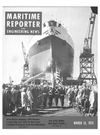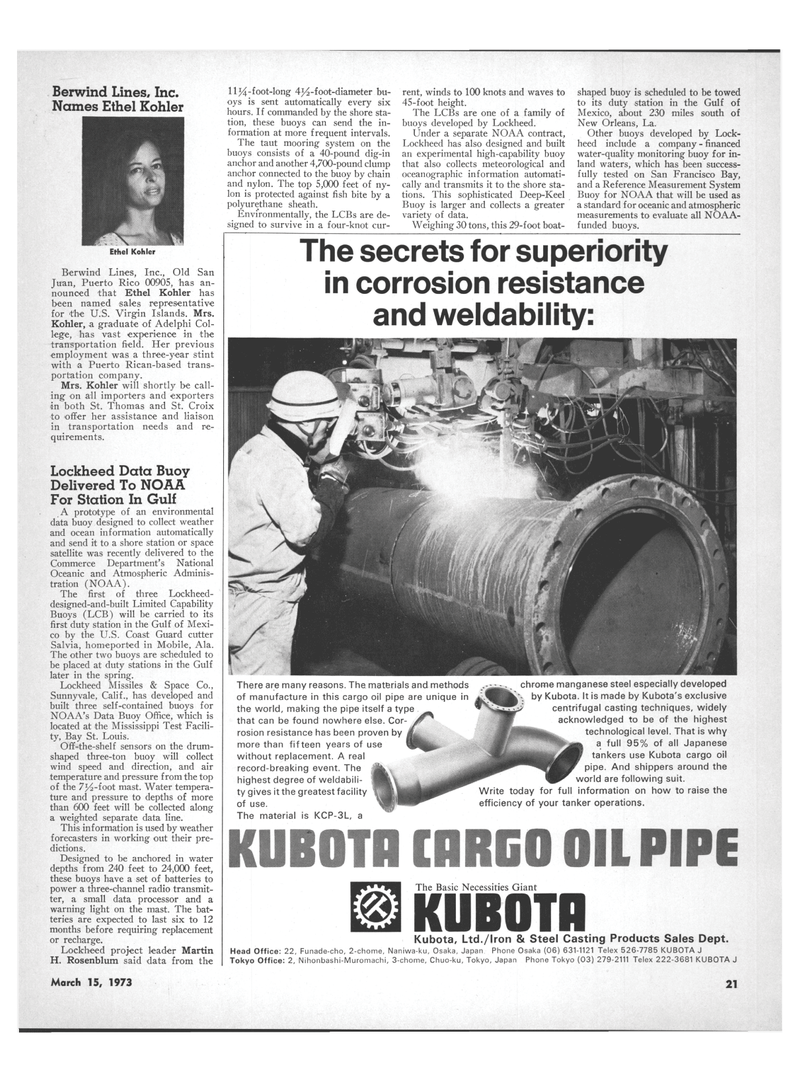
Page 19: of Maritime Reporter Magazine (March 15, 1973)
Read this page in Pdf, Flash or Html5 edition of March 15, 1973 Maritime Reporter Magazine
Berwind Lines, Inc.
Names Ethel Kohler
Ethel Kohler
Berwind Lines, Inc., Old San
Juan, Puerto Rico 00905, has an- nounced that Ethel Kohler has been named sales representative for the U.S. Virgin Islands. Mrs.
Kohler, a graduate of Adelphi Col- lege, has vast experience in the transportation field. Her previous employment was a three-year stint with a Puerto Rican-based trans- portation company.
Mrs. Kohler will shortly be call- ing on all importers and exporters in both St. Thomas and St. Croix to offer her assistance and liaison in transportation needs and re- quirements.
Lockheed Data Buoy
Delivered To NOAA
For Station In Gulf
A prototype of an environmental data buoy designed to collect weather and ocean information automatically and send it to a shore station or space satellite was recently delivered to the
Commerce Department's National
Oceanic and Atmospheric Adminis- tration (NOAA).
The first of three Lockheed- designed-and-built Limited Capability
Buoys (LCB) will be carried to its first duty station in the Gulf of Mexi- co by the U.S. Coast Guard cutter
Salvia, homeported in Mobile, Ala.
The other two buoys are scheduled to be placed at duty stations in the Gulf later in the spring.
Lockheed Missiles & Space Co.,
Sunnyvale, Calif., has developed and built three self-contained buoys for
NOAA's Data Buoy Office, which is located at the Mississippi Test Facili- ty, Bay St. Louis.
Off-the-shelf sensors on the drum- shaped three-ton buoy will collect wind speed and direction, and air temperature and pressure from the top of the 7^2-foot mast. Water tempera- ture and pressure to depths of more than 600 feet will be collected along a weighted separate data line.
This information is used by weather forecasters in working out their pre- dictions.
Designed to be anchored in water depths from 240 feet to 24,000 feet, these buoys have a set of batteries to power a three-channel radio transmit- ter, a small data processor and a warning light on the mast. The bat- teries are expected to last six to 12 months before requiring replacement or recharge.
Lockheed project leader Martin
H. Rosenblum said data from the 11 Y\-foot-long 4^-foot-diameter bu- oys is sent automatically every six hours. If commanded by the shore sta- tion, these buoys can send the in- formation at more frequent intervals.
The taut mooring system on the buoys consists of a 40-pound dig-in anchor and another 4,700-pound clump anchor connected to the buoy by chain and nylon. The top 5,000 feet of ny- lon is protected against fish bite by a polyurethane sheath.
Environmentally, the LCBs are de- signed to survive in a four-knot cur- rent, winds to 100 knots and waves to 45-foot height.
The LCBs are one of a family of buoys developed by Lockheed.
Under a separate NOAA contract,
Lockheed has also designed and built an experimental high-capability buoy that also collects meteorological and oceanographic information automati- cally and transmits it to the shore sta- tions. This sophisticated Deep-Keel
Buoy is larger and collects a greater variety of data.
Weighing 30 tons, this 29-foot boat- shaped buoy is scheduled to be towed to its duty station in the Gulf of
Mexico, about 230 miles south of
New Orleans, La.
Other buoys developed by Lock- heed include a company - financed water-quality monitoring buoy for in- land waters, which has been success- fully tested on San Francisco Bay, and a Reference Measurement System
Buoy for NOAA that will be used as a standard for oceanic and atmospheric measurements to evaluate all NOAA- funded buoys.
The secrets for superiority in corrosion resistance and weldability:
KUB0TRIRRG0 OIL PIPE
The Basic Necessities Giant
Kubota, Ltd./Iron & Steel Casting Products Sales Dept.
Head Office: 22, Funade-cho, 2-chome, Naniwa-ku, Osaka, Japan Phone Osaka (06) 631-1121 Telex 526-7785 KUBOTA J
Tokyo Office: 2, Nihonbashi-Muromachi, 3-chome, Chuo-ku, Tokyo, Japan Phone Tokyo (03) 279-2111 Telex 222-3681 KUBOTA J
There are many reasons. The materials and methods of manufacture in this cargo oil pipe are unique in the world, making the pipe itself a type that can be found nowhere else. Cor- rosion resistance has been proven by more than fifteen years of use without replacement. A real record-breaking event. The highest degree of weldabili- ty gives it the greatest facility of use.
The material is KCP-3L, a chrome manganese steel especially developed by Kubota. It is made by Kubota's exclusive centrifugal casting techniques, widely acknowledged to be of the highest technological level. That is why a full 95% of all Japanese tankers use Kubota cargo oil pipe. And shippers around the world are following suit.
Write today for full information on how to raise the efficiency of your tanker operations.
March 15, 1973 21

 18
18

 20
20
